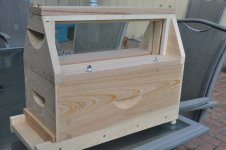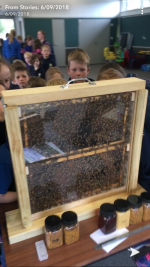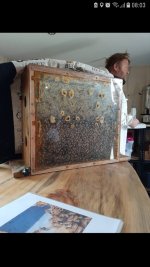This written about 25 years ago, I think...
Observation hives...
I've used a variety of observation hives, including a 1 frame 'portable', a 2 frame not quite so portable and a 4 frame vertical. And I agree with Kerry Clark - the 4 frame was withoutdoubt the best for a permanent location. The 2 framer I only ever used as temporary - run out and grab a few frames, one with honey, one with brood. Find the marked queen to put on it. And brace it well in the car (it was perspex...).
One design (Russian?) that always intrigued me had one or two vertical frames (one frame wide, that is), then a strip of queen excluder, then, effectively, a 4 frame nuc fitted on top. The 4 frame area was closed in (not glass) and acted as a reservoir for bees/honey that allowed the unit to be more permanent.
Two choices for how you fit the glass/perspex - 'onto' the surface (using clips, called 'mirror clips', I think,
___
__|XXXXXXX
to fix the glass/perspex against the surface). Or sliding the glass/perspex into a groove from the top of the observation hive (only really possible with perspex). Latter gives less air leakage around the edges - I found the bees didn't care for that (lots standing facing the draught at the edges).
Make SURE you have adequate means of dealing with condensation - build in HEAPS of mesh, etc, even if you have to keep it covered.
But I found no trouble with 25mm (1in) square of mesh at top and bottom of hive. Especially just after installing, you'll be amazed at the moisture given off.
Perspex tended to craze after several years, not being as sparkly clean as when first made. Glass is easier to write on - its neat to circle eggs, and date them, watching the development.
If for a permanent location, you can have heaps of fun designing entrance ways that allow you to 'draft' individual bees into side chamber, where you could, say, mark them or remove pollen, etc. And you can by having a wide entrance, arrange to have incoming bees going down one side and outgoing down another:
. ---------------------------------
.colony -----\ <---incoming
. \ bees
. ---> \-------------------------
. ---------------------------------
For a unit that you'll be moving alot, or if it will be worked regularly, work out a way of easily closing off the entrance and being able to take the whole unit outside - much better than trying to do bee work inside a classroom, for instance.
Design some sort of feeder system, too, for a permanent unit - they'll need a lot of babying along in most locations. You may need to top them up with bees/brood. And in a good season, they'll be able to generate more swarms than you'd think possible!
REFERENCES
Stevenson, Lt H R. 1985. Establish an observation hive and promote beekeeping! Amer Bee Journal. February 1985, pp 89-90.
Gale, Dr F C. 1972. Observation beehives. Amer Bee Journal. 112(1): 8-9.
Taber, Steve. 1980. Bee behavior. Amer Bee Journal. January 1980, pp 14-15.
Gary, N E. 1968. A glass-walled observation hive. Amer Bee Journal 108(3):92-94, 108(4):143-144, 146.
Connor, L J. 1974. Observation bee hives. Beekeeping Information Number 10. Entomology Extension, Ohio State University, Columbus, OH 43210. 4 pp.
Bosch, K. 1980. The observation hive and scale colony - two important tools. Amer Bee Journal 120(10):712-715, 721.
Pedigo, Bobby. 1985. This is what we call a real observation hive. Amer Bee Journal. Nov 1985, pp 737-738 (letter to editor with photograph).
Lindauer, M. 1961. Communication among social bees. Harvard Univ Press, Cambridge, MA., p 17.
Gojermac, Walter L. Building and operating an observation hive. Univ of Wisc-Extension bulletin A2491. 6pp.
Witherell, Peter C. 1970. Behavior of honeybees in glass-covered runways. Gleanings in Bee Culture. November 1970, pp 564-668.
Blanchet, Felix. 1979. Honey producing observation hive. Amer Bee Journal. February 1979. pp 114-115,137.
Lehnert, T and Cantwell, George E. 1966. The Beltsville research apiarium. Amer Bee Journal 106(9):336-337.
Anonymous. 1949. Single-frame observation hive. Co-operative Extension work in Agric and Home Economics, North Carolina State
College and U S Dept of Agriculture Cooperating. 1pp.
Caron, D M. 1979. Observation bee colonies. Entomology Leaflet 103, Dept Entomology, Univ Maryland, College Park, MD 20742. 14pp.
Gary, N E and Lorenzen, K. 1976. How to construct and maintain an observation hive. Dev Agr Sci, Univ California Leaflet 2853. 18pp.
Jaycox, E R. 1973. Making and using an observation bee hive. Dept Hort, Univ Illinois Publ H-678, Urbana, IL 61801. 4pp.





